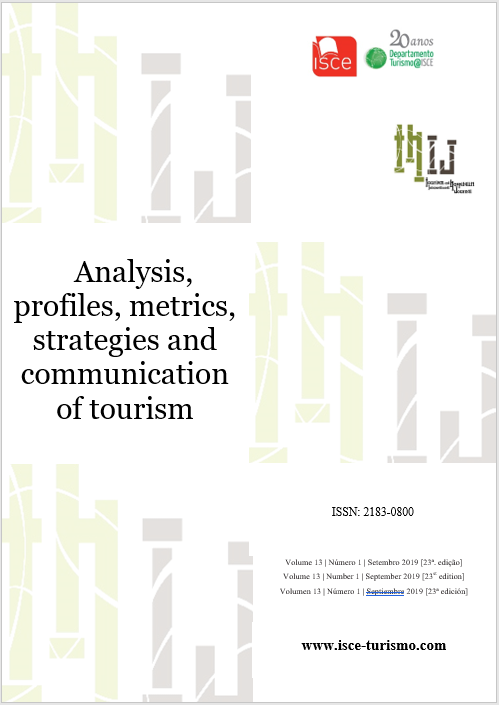Profile and mobility of senior tourists during their stay in Algarve
DOI:
https://doi.org/10.57883/thij13(1)2019.30620Keywords:
Senior tourists, Mobility, Algarve, Transport, ProfileAbstract
The mobility of tourists and residents in tourism destinations is an important topic of research, due to all the dynamics and actors evolved. This paper is part of the Scientific Research and Technological Development (IC&DT) Project “Accessibility for All in Tourism” (Acces4all). It aims to present the results of the questionnaires applied at Faro International Airport to senior tourists on their day of departure, between April and September 2018, in order to evaluate their profile and some of the main characteristics of their mobility in their home country and during their stay in the Algarve. The data collected allow the validation of 851 questionnaires. The respondents profile mainly points to people with mobility problems at the motor level (61.6%), who need technical support to move, namely cane (31.3%), crutches (16.2%), wheelchair (12.3%) or a tripod cane (12.3%). Little or no use of public transport in everyday life is mainly associated with difficulty walking (34.3%) or climbing stairs (32.6%). During their stay in the Algarve, respondents use almost exclusively private transport, such as taxi or Uber services (43.8%), organized transfers between the airport and accommodation (36.2%), between accommodation and the airport (33.5%), as well as rent-a-car services (31.7%). There is little or no demand for public transport. The reasons for choosing organized transport on the day of arrival and departure are mainly due to the ease and speed of the service (49.9%) and the lack of public transport at destination (38.3%).
References
Carvalho, I. (2015). O turismo acessível: Estratégias de adaptação de uma cidade. O caso de Lisboa. Tese de doutoramento, Turismo (Gestão de Destinos e Produtos Turísticos), Universidade de Lisboa, Instituto de Geografia e Ordenamento do Território.
Costa, F.; Ribeiro de Almeida, C. & Martins, A. (2017). Turismo acessível. Boas práticas, desenvolvimento e desafios na Região do Algarve. Omnia, 6, 25-38.
Davenport, J. & Davenport, J. (2006). The impact of tourism and personal leisure transport on coastal environments: A review. Estuarine, Coastal and Shelf Science, 67, 280-292.
Devile, E. (2009). O desenvolvimento do turismo acessível: dos argumentos sociais aos argumentos de mercado. Revista Turismo e Desenvolvimento, 11, 39-46.
Duval, D.T. (2007). Tourism and transport: Modes, networks and flows. Channel View Publications: Clevedon, UK.
Filimonau, V., Dickinson, J. & Robbins, D. (2014). The carbon impact of short-haul tourism: A case study of UK travel to Southern France using life cycle analysis. Journal of Cleaner Production, 64, 628-638.
Gronau, W. & Kagermeier, A. (2007). Key factors for successful leisure and tourism public transport provision. Journal of Transport Geography, 15(2), 127–135.
Gutierrez, A. & Miravet, D. (2016). The determinants of tourist use of public transport at the destination. Sustainability, 8(9).
Le-Klähn, D. T., Gerike, R. & Hall, C.M. (2014). Visitor users vs. non-users of public transport: The case of Munich, Germany. Journal of Destination Marketing & Management, 3(3), 152–161.
Lumsdon, L. & Page, S. J. (2004). Tourism and transport: Issues and agenda for the new millennium. Amsterdam: Elsevier Science Ltd.
Maroco, J. (2007). Análise estatística com utilização do SPSS (3ª edição). Edições Sílabo.
Page, S. (2005). Transport and tourism: Global perspectives. Harlow: Pearson, UK.
Peeters, P., Szimba, E. & Duijnisveld, M. (2007). Major environmental impacts of European tourist transport. Journal of Transport Geography, 15(2), 83-93.
Prideaux, B. (2000). The role of the transport system in destination development. Tourism Management, 21(1), 53–63.
Riganti, P. & Nijkamp, P. (2008). Congestion in popular tourist areas: A multi-attribute experimental choice analysis of willingness-to-wait in Amsterdam. Tourism Economics, 14(1), 25-44.
Rosa, M. & Gil, F. (2017). Design Universal. A necessidade de uma abordagem transdisciplinar. Omnia, 6, 15-24.
Rosa, M. P. & Lopes, J. C. (2019). Senior tourists’ perceptions of bus stop environments, WIT transactions on the built environment, 186, WIT Press. ISSN 1743-3509.
Scott, D., Gössling, S. & Hall, C. M. (2012). Tourism and climate change: Impacts, adaptation and mitigation. Abingdon, UK: Routledge.
Sorupia, E. (2005). Rethinking the role of transportation in tourism. Proceedings of the Eastern Asia Society for Transportation Studies, 5, 1767-1777.
Thompson, K. & Schofield, P. (2007). An investigation of the relationship between public transport performance and destination satisfaction. Journal of Transport Geography, 15(2), 136-144.
Turismo de Portugal (2012). Guia de boas práticas de acessibilidade na hotelaria. Lisboa: Ministério da Economia e do Emprego. Retirado de https://bit.ly/2KakCUv, em 10/05/2018.
UNWTO (2016). Turismo accesible para todos: Una oportunidad a nuestro alcance. Organização Mundial de Turismo. Retirado de https://bit.ly/2ywTQ1W, em 11/04/ 2019).
WHO (2011). World report on disability 2011. World Health Organization. Retirado de https://bit.ly/2GG2QGE, em 22/10/2018).
Downloads
Published
How to Cite
Issue
Section
License
Copyright (c) 2023 This work is licensed under a Creative Commons - Attribution 4.0 International (CC BY 4.0)

This work is licensed under a Creative Commons Attribution 4.0 International License.
This work is published under the Creative Commons Attribution 4.0 International License.






